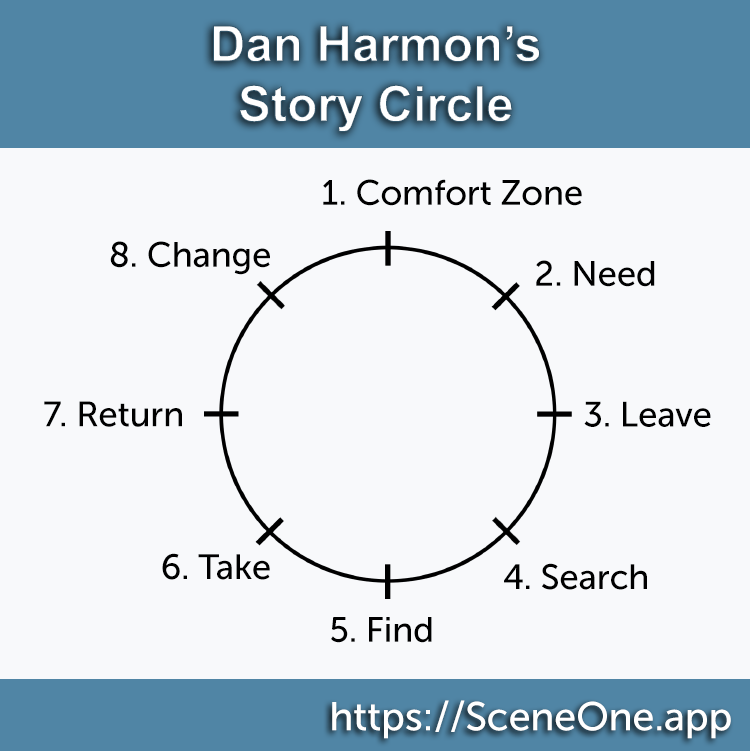What are the eight beats of the Story Circle structure by Dan Harmon?
This article is a very quick run-down of the 8 beats of the Story Circle structure by Dan Harmon. It will either help to refresh your memory, or will prime you before jumping into our full guide on Dan Harmon's Story Circle structure, which we recently revamped.
What is the Story Circle Structure used for?
Like all story structures such as Save the Cat, the Hero's Journey, or even the Heroin's Journey(!), Dan Harmon's Story Circle will help you to quickly get a high-level bird's-eye-view of your overall story. This can be used for novels, screen plays, stage plays, or any type of story!
You probably already have some good ideas of the events and themes and characters you want to write about, but the Story Circle (just like every other story structure) will identify the gaps you still need to fill even. It's even useful if you're already written a draft, as it'll give you ideas of what might be missing.

What are the main beats of Dan Harmon's Story Circle?
These are the eight main beats:
Story Circle beats in detail
Let's quickly explain each beat, but don't forget that you can check out our full guide to Dan Harmon's Story Circle Structure for much more detail!
1. Comfort Zone
We meet our main character in their normal, comfortable life. Sometimes this isn't literal "comfort" (maybe they're dirt-poor and struggling to work three jobs), but change is scary and difficult.
2. Need
We learn what the characer needs in their life. This could be something "physical" like to pay off a debt or find enough money for their kid's medication. Or it could be something psychological or existential, such as wanting social inclusion or a purpose in their life.
3. Leave
The pursuit of their need forces them over a threshold. You can imagine this as the simple farm boy being forced to leave the town on a quest, but it's really just the character breaking out of their regular, safe comfort zone in an effort to change things up.
4. Search
In their "search" for their need, they go through a series of trials. This is often called the "Try/fail cycle", where characters make plans, try to execute them, but fail for one reason or another. This is often here the "fun stuff", or the "cool struff from the trailer" happens. Also, usually, one of the big reasons our heroes keep failing at this part is because they haven't yet learned whatever lesson they need to learn in order to obtain their goals. i.e., they keep on making the same mistakes over and over again.
5. Find
They actually get their desire from #2! They get it, whether they like it or not. Because maybe the girl gets the guy she's been lusting over... but the guy's a big jerk who's texting other girls. Or maybe valuable treasure is actually a monkey paw. Or, you know, maybe this time your character actually gets exactly what they needed and wanted! (Sometimes happy stories occur!)
6. Take
But while they find their need and desire - and get to take it - they also have to pay a price. Just like in #4, Search, this is where some of the "cool stuff" can happen: the heroes have one last big fight against the villains, or they discover an unforeseen consequence of the prize they've wanted for so long. This is where we'll see all those consequences!
7. Return
With all that said and done, they return back to where they began in their "comfort zone". There's often an amount of wiggle-room with this step, as maybe your story doesn't need the reader/viewer to see the characters make it all the way back to the village or their studio apartment. Sometimes it's enough to just see the characters without any more threats against them, as they've now vanquished their enemeies.
Keep in mind that that while these examples tend to lean on action stories or sci-fi/fantasy settings, it all still applies equally to office dramas and period pieces. The "return to their comfort zone" in an office would just be a place where their office bully no longer works there or has any power over them. Or it could be that the tax collector is no longer trying to reposses the Lord's manor.
8. Change
Now that the hero is back home with their needs fully met... they discover that they've changed in one way or another. Maybe they're less scared, more confident, healthier, richer, happier. Usually this is all for the better, and the main characters are more equiped to handle their next adventure in the sequal! But, sometimes, our stories are tragedies that leave our characters changed for the worse.
